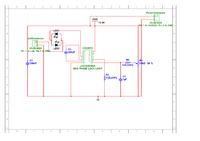devesha
Newbie level 2
Hi all, I'm working on a project where a standing resonance is a must.
I've already made many parts of my project and now I'm in the phase of the tuning.
What I need is a schematic which can accomplish two needs:
Let me give a simple example: I have a transformer (for the sake of simplicity) which I make it to oscillate, on the primary side, with a function generator, square wave, 35 kHz (there is a driver and a mosfet in the middle between the fgen and the transformer, but this is not important now); I've found the correct capacitance to get both the primary side and secondary side to resonate but, once an inductive load is connected on the secondary side, an imbalance occurs and the resonance is lost... of course I can adjust that imbalance using a new capacitor's value, accordingly with my load but...unfortunately, the load is not always the same: sometimes I have one kind of load, some other times there is another kind of load.
The kind of load, in my application, is unpredictable: in some cases it is not inductive but, instead, capacitive or resistive.
So I thought to the varicap (varactor) which can be voltage-controlled by a micro (Arduino in my case) but these kind of components have a so low capacitance values (in the order of few pF) that this makes them useless for my purposes. Furthermore, in the presence of so high voltage peaks, they will be destroyed in microseconds!
Could someone give a viable solution?
Many, many thanks in advance
I've already made many parts of my project and now I'm in the phase of the tuning.
What I need is a schematic which can accomplish two needs:
- to sense/detect the resonant state of both sides of a coil, made of a primary and a secondary side - so a resonance detector
- to adapt/adjust the capacitance (or the inductance) of the secondary side of my coil when a variable load is connected (e.g. an inductive load) - so a dynamic resonance tuner
Let me give a simple example: I have a transformer (for the sake of simplicity) which I make it to oscillate, on the primary side, with a function generator, square wave, 35 kHz (there is a driver and a mosfet in the middle between the fgen and the transformer, but this is not important now); I've found the correct capacitance to get both the primary side and secondary side to resonate but, once an inductive load is connected on the secondary side, an imbalance occurs and the resonance is lost... of course I can adjust that imbalance using a new capacitor's value, accordingly with my load but...unfortunately, the load is not always the same: sometimes I have one kind of load, some other times there is another kind of load.
The kind of load, in my application, is unpredictable: in some cases it is not inductive but, instead, capacitive or resistive.
So I thought to the varicap (varactor) which can be voltage-controlled by a micro (Arduino in my case) but these kind of components have a so low capacitance values (in the order of few pF) that this makes them useless for my purposes. Furthermore, in the presence of so high voltage peaks, they will be destroyed in microseconds!
Could someone give a viable solution?
Many, many thanks in advance
Last edited by a moderator:
